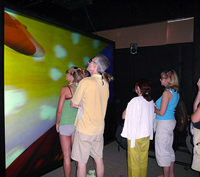Rutopia 2 Presentation at SIGGRAPH 2007
August 4th, 2007 - August 6th, 2007
Categories: Cultural Heritage, Multimedia, Tele-Immersion, Visualization, VR Art

About
Daria Tsoupikova and Alex Hill presented VR art installation Rutopia 2 at the SIGGRAPH 2007 Art Gallery on August 4-6th at the state-of-the-art facilities of the California Institute for Telecommunications and Information Technology (Calit2) and the Center for Research in Computing and the Arts (CRCA) at the University of California, San Diego.
SIGGRAPH 2007, the 34th International Conference on Computer Graphics and Interactive Techniques gathered computer graphics and interactive technology professionals from six continents to present industry’s most respected technical and creative programs focusing on research, science, art, animation, gaming, interactivity, education, and the web at the San Diego Convention Center.
Rutopia 2 is a virtual reality (VR) art project built for the C-wall VR system. It explores the aesthetics of virtual art in relation to traditional Russian folk arts and crafts such as wood sculpture, toys and the decorative painting styles of Palekh, Khokhloma, and Dymkovo.
Rutopia 2 aesthetics are based on the generalized outlines, principles of composition, bright colors and simplified shapes inspired by these styles. The project describes a magic garden with interactive sculptural trees. It was conceived as a virtual environment linked to a matrix of several other unique virtual environments that together create a shared network community. A series of 3D modular sculptural trees, each consisting of dozens of rectangular screens, appear in the main environment and serve as portals to the other linked environments.
The animation of these dynamic tiled trees is an attempt to break through the static flatness of the contemporary tiled-display grids, architectural facades, and surfaces into the perpetually changing 3D sculptural forms of the ubiquitous public network. Users can “grow” three trees in the island world by moving within the proximity of each tree. Each tree appears as a rapid sequence of flipping and rotating rectangular screens expanding out and upward.
Once all the trees are fully grown, their screens turn into windows and the island changes from monochrome to color. Each window shows the view of the remote environment connected to it. Just as we can look through a window and see the outside, the user can look through each of the screens to see remote worlds consisting of imagery found in traditional Russian fairytales and folk art. By moving his or her head completely through one of the virtual screens, the user enters the connected environments.
The project implementation utilized OpenGL Performer, Maya, CAVElib, the Bergen spatialized sound server and the recent improvements and advanced rendering techniques in Ygdrasil.